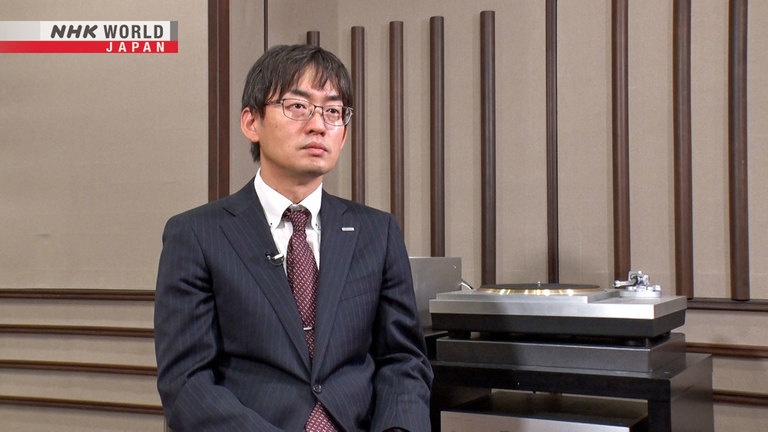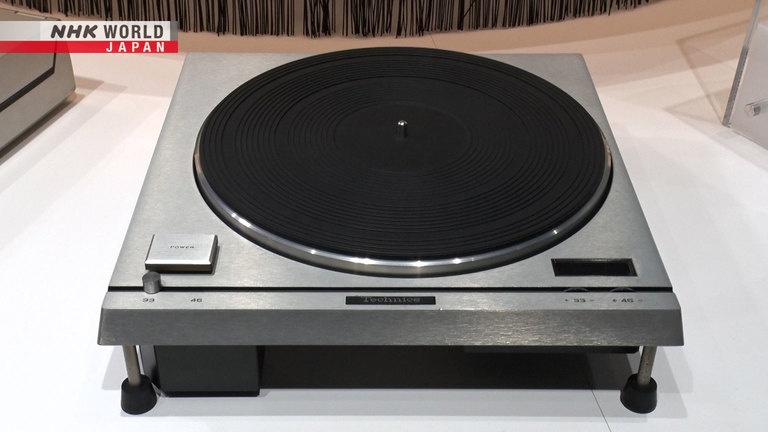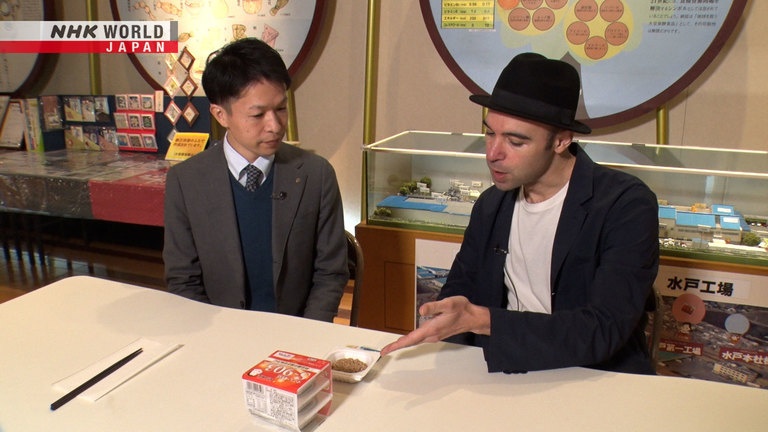Direct Drive Turntables / Natto
The stories behind hit Japanese products, plus top creations for niche markets. This time: direct drive turntables & natto.



Transcript
"Japan's Top Inventions"
The behind-the-scenes tales of hit products and creations from Japan.
This is "Japan's Top Inventions."
On today's show... direct drive turntables.
They're the choice of DJs around the world.
We'll share how they were invented.
Later...
A factory which makes a popular Japanese food.
It's fermented over 14 hours.
Can you tell what it is?
Hello, welcome to "Japan's Top Inventions."
I'm your host, Jason Danielson.
In the first half of our show, we take you "Behind the Creation."
Today's topic is this.
The direct drive turntable, developed in 1970.
Previous record players were driven using a motor and belt.
This turntable was the first in the world
to spin the record directly with the motor.
The technology reduced the amount of maintenance required,
making it a popular choice for broadcasters around the world.
It was developed by a major Japanese electronics manufacturer.
The company had set out to change the conventions of the record player.
Osaka.
The museum of a major electronics manufacturer.
Inside, you can find products from over the decades.
Over in one display...
This is the original model.
The world's first direct drive turntable.
This motor is at the heart of the device.
It spins the record directly during playback.
This product became a surprise hit with a certain demographic.
DJs.
The devices enabled the DJ technique known as "scratching,"
which gained popularity worldwide.
Our story begins back in the 1960s.
Japan was experiencing strong economic growth,
and more people were getting into audio.
There was an audio product boom,
with companies worldwide developing record players.
One major manufacturer joined the competition late.
At the time, the popular high-end machines were imports from overseas.
How could they stand out from the competition?
The company carefully evaluated their options.
This is Okuda Tadayoshi,
who currently develops turntables at the company.
Here's what he heard about those times.
Foreign products and European companies dominated the record player market.
To go up against Europe and America,
the company would need to have a unique product.
One day...
A request came in from an audio enthusiast living in a cold region of Japan.
"The belt in my record player is losing flexibility
and that's affecting the disk spinning.
Is there anything you can do about that?"
Most record players at that time featured a motor,
platter, and rubber belt.
This is known as a belt drive turntable.
Temperature changes could cause the belt to shrink and expand,
affecting the playback of the record.
It's especially a problem in cold areas.
The belt shrinks and expands,
so the speed of the rotation ends up changing slightly
even though you want it to be at a constant speed.
The sound can get a bit wonky, and the tone becomes inconsistent.
Creating a record player that could spin more consistently
would set the company apart from the competition.
The development team got to work immediately.
A record player which wouldn't use a belt.
The developers immediately ran into a major hurdle.
What would they do about the motor?
An LP record spins at around 33 revolutions per minute,
a relatively slow speed.
The motor itself spins much faster,
but is linked to the platter with a belt to reduce the speed.
No belt meant that the motor itself would have to move at low speed.
Where could the team find such a motor?
They had an unexpected source of aid.
The company's wireless research laboratory.
The developers there had succeeded
in decreasing the speed of a motor using circuit boards.
They were able to create an ultra-low-speed motor.
The turntable developers received one of those motors from the lab.
They would try attaching it underneath a record player.
They loaded a record right above the motor
and measured everything from RPM to vibrations.
They checked all of that.
Hopeful, the developers started it up.
The turntable began to spin.
The team tested over and over again,
making small improvements to the motor.
They kept making adjustments
until they reached the correct speed for playing back records.
Next, the team tested their player in a temperature-controlled room.
They needed to see whether their new player
would work in low temperatures.
The team put the device in a room for tests with temperature.
The players might be used in Nordic countries or other cold European regions.
If the player didn't work in those conditions,
that would certainly be bad for the customer.
The prototype was put in the temperature-controlled room.
The thermostat was set to zero degrees Celsius.
Would the rotation be affected?
The test began.
The temperature continued to drop.
Even at below zero, the turntable kept spinning.
And the rotation speed? Constant.
"Perfect."
But just as they were about to celebrate,
the developers set the temperature above 30 degrees Celsius for summer.
That was when the speed started to change.
The higher the temperature, the bigger the problem.
As the temperature went up, the RPM started to change.
There were even times when the motor would spin out of control.
Issues like that kept happening.
A player which didn't work in the summer would never make it to market.
The team were at a wall.
A record player without a belt,
which spun the record directly with the motor.
Fluctuations in a player's revolutions per minute
causes irregularities when playing back the music.
The development team worked diligently to solve
the issue of high temperatures affecting the speed.
Eventually, they were able to hit a breakthrough.
The team continued to test ways to deal with the temperature problem.
They arrived at a certain idea.
To add a pitch control dial which would adjust the speed of the player.
If the speed was fluctuating due to the temperature,
all you needed to do was adjust the dial
until the lines behind the viewing window became still.
With the technology at the time,
temperature changes would cause fluctuations in the rotating speed.
When that happened, the users could use the pitch control
to correct the speed themselves.
With that, the temperature issue was solved.
But there was one more thing that needed to be addressed.
The vibration of the motor.
Motors spin through the interaction of magnetic forces within them.
These forces cause vibration.
These vibrations were an issue with belt-driven turntables.
The platter would vibrate during playback, resulting in noise.
How much of an issue would this be with their new motor?
Measurements of their machine were showing significant vibrations.
There are everyday vibrations which you would never notice on your own.
But a record player picks up tiny grooves on the disk
and amplifies that by 1,000 or 10,000 times,
so those tiny vibrations become audible.
Large vibrations continued to be measured on the prototype.
But was it actually from the motor?
The team continued to investigate.
One day, a member had a thought.
Commuter trains passed by the company offices.
The vibration from the trains shook the building.
The train would clatter and shake things a bit.
A passing carriage would have added noise to their measurements
and contributed to unwanted results.
So they thought to try under quieter conditions.
The team had a plan.
They would change when their tests took place.
They began past midnight, after the trains had stopped.
A blank record was prepared.
By playing this, they would be able to catch every noise
which occurred without the music distracting.
For testing, they had a record with no music on it,
the grooves were all silent.
For the test to be successful,
the developers would not hear anything, no noise.
The record was placed...
And the needle, lowered.
Nervously, the developers watched the turntable spin.
Silence. Complete silence.
It was silent during the test.
Hearing no sound, no noise like before
was probably a real moment of relief for the developers.
They must have been overjoyed with that successful test.
Yes, definitely.
And so, in June of 1970, the first direct drive turntable was complete.
After the player hit the market, an unexpected customer reached out.
It was the British public broadcaster, based in London.
They were interested because a player with no belt required less maintenance.
As a result, broadcasters around the world began using the turntables.
Also, over in New York...
a team member was visiting a radio station which was using their player.
While on the air, the DJ told everyone,
"An engineer who we have to thank for
this noiseless playback is here in the studio."
That DJ told everyone during the radio program
that the turntable engineer was there at the studio.
That must have been a real thrill for the engineer.
It's not the kind of thing that happens very often.
He must have been really happy and honored to be recognized like that.
And so, the value of the direct drive turntable was made known.
The players would help deliver music to homes around the world.
A direct-drive turntable which spun records without using a belt.
How do experts view this invention?
We're joined by Obara Yoshio to learn more.
Welcome to the show.
Glad to be here.
What's your opinion on the first ever direct drive turntable?
Motors are generally designed to spin as fast as possible.
But the motor in this case was specially designed to spin slowly.
They brought together the best tech
to spin the record slowly, correctly, and consistently.
Being able to do this was the key to the direct drive turntable.
I'd say it was a groundbreaking achievement.
I hear you have one of the early models at home.
What do you like about it?
It's truly noiseless. That's the key.
Because there is no noise,
all the subtle signals engraved on the record are brought to life.
That's what stands out to me about this direct drive turntable.
Many people today stream music online.
What kinds of fans are attracted to record players?
The current revival with analog records is
something like a fashion trend with younger people.
It's a new media for them.
Also, in the West, and Southeast Asia in particular,
Japanese city pop from the 70s and 80s has become really chic.
You have fans coming to Japan on vacation
just to search used record stores for these disks.
Thanks to people like these fans, Japanese records,
and vinyl in general, is enjoying a revival around the world.
What do you think Japanese companies can offer
to all those vinyl-lovers out there?
Quite a few Japanese companies are still making record players.
You have ones ranging from a few hundred to over a thousand dollars,
each with different specs.
It's significant that Japanese companies
can offer a lineup of different models.
Also, there's another important element for turntables.
The needle.
Most of the needles in the world are actually
being made by Japanese companies.
Japan's making a large contribution
by putting out a lot of the players and needles on the market right now.
Thank you for your time. Great speaking with you.
Same here, thanks.
Top Niche Creations.
Our next segment is "Top Niche Creations."
Today we're looking at this.
Natto, a traditional Japanese food.
Natto is made by fermenting soybeans.
Consumption of natto has been on the rise,
and Japanese supermarkets sell many different varieties.
The top manufacturer of natto is located in Ibaraki,
a prefecture famous for the product.
Just what kinds of natto do they make?
We sent our reporter to find out.
Hey, everyone. Cyrus Nozomu Sethna here.
Today, I'm in Ibaraki Prefecture,
which is about 85 kilometers northeast of Tokyo.
Today, we are visiting the largest manufacturer of natto in Japan.
Come and join me!
I'm at a natto manufacturer that started 92 years ago.
Hello! Nice to meet you.
Welcome.
My guide is Ichimura Shinji, who is involved with product development.
Inside the company...
Whoa!
Look at all that.
A lineup of all the natto products.
There are over 20 varieties.
What's the difference between them?
So how are these different?
First off, there's the difference in bean size.
The larger ones are on this side.
There are large beans...
Smalls beans...
And ones that have been crushed.
Why are there all these different sizes?
Many Japanese people enjoy natto,
and they have their preferences.
The smaller beans go well with rice, so they are very popular.
But there are people who want to really taste the bean,
so they eat the larger variety on its own without rice.
I see.
How exactly is natto made?
Here's a look at the manufacturing process.
Soybeans are soaked in water and steamed at over 100 degrees Celsius.
Then, natto probiotic cultures are applied.
These microorganisms ferment the soybeans,
creating natto's signature texture.
Different probiotic cultures result in variations in the texture.
We were shown the difference.
This is the stickiest type.
Very sticky.
You can lift it all and it stays together.
All bunched up!
We were shown a type which is less sticky.
The beans keep dropping as they're lifted.
The less sticky one starts falling right away.
Yeah, the stronger one basically stayed together.
Another important part of natto is the dressing.
Soy sauce and mustard are the standard flavors.
Natto has a distinct odor,
so mustard is often used to mask that and add flavor.
And another dressing?
This one has a different color.
Wasabi.
Oh, wasabi, I see.
I'm a big fan of natto.
So, I try the wasabi dressing.
The wasabi really hits the spot.
Wasabi usually goes with sushi, but it goes great here too.
In fact, I think I like this combination more than the standard dressing.
There's even one like this.
There are some chopped bits in it.
How does it taste?
It's sweet and flavorful.
The sauce is "shiso" leaf and seaweed flavor.
A variety of products and flavors are available
so that customers can try something new.
You're able to make many varieties, huh?
Yes. You can vary the probiotic cultures or the dressings.
There are infinite combinations.
With its diverse lineup,
the company has the largest share of the domestic market.
It was founded in 1932.
It's located in Ibaraki, where natto has long been eaten.
While many small companies already existed,
this company went for mass production,
making deals with supermarket chains.
The key to winning the market was the probiotic cultures.
These microorganisms can be found in nature, soil, and grass.
The company's research facilities
have natto probiotic cultures from across the country.
They have over 2,000 varieties.
This one was designated as number 903.
It has a unique effect which has led to new product development.
It can help improve immune response.
It helped reduce mucus production in people suffering from hay fever.
In mice, it inhibited the reproduction of influenza viruses.
This special natto also comes with a dressing
which has lactic acid bacteria.
It became a hit product with health-conscious consumers.
One pack of dressing contains ten billion lactic acid bacteria.
Amazing. Are you still finding new cultures?
Rather than discovering new ones,
we're analyzing the characteristics of the ones we've collected.
I really think natto and natto probiotics have limitless potential.
We hope to keep researching
and discovering exciting new things with natto.
Great stuff.
The probiotics in natto can have some unexpected benefits.
Recently, the company published the results of their research
in an area you might not expect.
Fish farming.
Over a period of 12 days,
carp were fed fish food mixed with natto probiotics.
It was found that these carp grew at double the rate
compared to those that were fed regular food.
Who would have thought that the probiotics in natto
would be good for fish as well. Wow!
That's all for this episode of "Japan's Top Inventions."
We'll leave you with more about the turntables from the first half of the show.
See you next time! And stay inventive.
(People around the world continue to enjoy music on vinyl.)
(Record players are central to this.)
(The first direct-drive turntable spun the disk directly.)
(The key component was the low-speed motor.)
(Later, similar technology was used for audio cassettes and video tapes.)
(Turntable developer Okuda reflects on the achievements of his predecessors.)
They tried to go against conventions,
to try and make a meaningful change.
I myself also believe that it's important for engineers
to try and create new technology,
and that's what I'll keep doing.